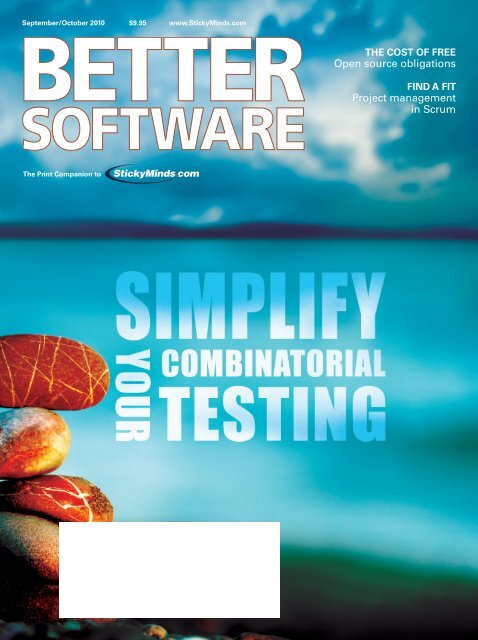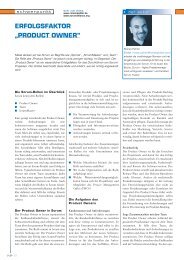Product Owners Should Care About Quality - Roman Pichler
Product Owners Should Care About Quality - Roman Pichler
Product Owners Should Care About Quality - Roman Pichler
You also want an ePaper? Increase the reach of your titles
YUMPU automatically turns print PDFs into web optimized ePapers that Google loves.
September/October 2010 $9.95 www.StickyMinds.com<br />
THE COST OF FREE<br />
Open source obligations<br />
FIND A FIT<br />
Project management<br />
in Scrum<br />
The Print Companion to
The Last Word<br />
<strong>Product</strong> <strong>Owners</strong> <strong>Should</strong> <strong>Care</strong><br />
<strong>About</strong> <strong>Quality</strong><br />
Software quality influences a product’s success, and the product owner is<br />
responsible for that success.<br />
by <strong>Roman</strong> <strong>Pichler</strong> | roman.pichler@romanpichler.com<br />
<strong>Product</strong> owners are responsible for product success. As a<br />
member of the Scrum team, the product owner collaborates<br />
with the ScrumMaster and team, as well as customers, users,<br />
and other stakeholders, to create a great product. Unfortunately,<br />
product owners often focus on delivering functionality<br />
and tend to neglect quality—rather than viewing quality as an<br />
enabler to deliver new features faster and to create lasting value.<br />
Why <strong>Should</strong> <strong>Quality</strong> Matter to <strong>Product</strong><br />
<strong>Owners</strong>?<br />
Software quality significantly impacts product success: It<br />
influences customer satisfaction and<br />
brand equity, impacts the total cost of<br />
ownership and life expectancy of the<br />
product, and determines the product’s<br />
competitiveness. Therefore, quality<br />
matters; it plays a key role in creating<br />
great products, as I explain in more detail<br />
below.<br />
Customers will only be satisfied if<br />
the product’s functionality works reliably<br />
and as expected. Defective software<br />
not only leaves customers dissatisfied,<br />
frustrated, or angry, but it also<br />
damages brand equity. Think about<br />
the issues Microsoft experienced with<br />
Windows Vista, including performance<br />
and interoperability problems. As a consequence, the company<br />
discontinued the Vista brand, calling its next operating<br />
system Windows 7. Only when quality meets functionality is<br />
true value created.<br />
Quickly releasing poor-quality software may achieve a<br />
short-term win, but it incurs technical debt—the software becomes<br />
difficult to extend and maintain. [1] This results in high<br />
development cost and long lead time for new functionality.<br />
Software with inadequate quality often has to be replaced<br />
sooner rather than later, resulting in a short life expectancy<br />
and a poor return on investment.<br />
Getting quality right is the prerequisite to leveraging customer<br />
feedback on early product increments, swiftly releasing<br />
software in response to the latest market development, and<br />
quickly bringing new functionality to the market. Compromising<br />
software quality means trading short-term gains for<br />
“Compromising software<br />
quality means trading<br />
short-term gains for<br />
longer-term growth,<br />
cheating the company of a<br />
better, brighter future.”<br />
longer-term growth, cheating the company of a better, brighter<br />
future.<br />
What Can <strong>Product</strong> <strong>Owners</strong> Do to Ensure<br />
<strong>Quality</strong>?<br />
As quality impacts product success, it should be a concern for<br />
the product owner as the individual who is first and foremost<br />
responsible for product success. To help get the quality right,<br />
product owners should apply the following recommendations:<br />
Think products, not projects. A product owner should be<br />
responsible for a product for an extended period of time and<br />
ultimately manage the product lifecycle.<br />
Embracing a product perspective<br />
means viewing a project as a means to<br />
an end—the project simply brings the<br />
next product version to life. Longerterm<br />
responsibility counteracts the<br />
temptation to compromise quality in<br />
order to finish the current project fast<br />
and get the next release out as soon<br />
as possible. “Thinking products, not<br />
projects” creates a desire for sustained<br />
success and encourages long-term<br />
thinking.<br />
Create a common understanding of<br />
quality. Make sure that a definition of<br />
“done” is available for each product<br />
and apply that definition properly. The definition should<br />
clearly state the general quality criteria that product increments<br />
must fulfill. “Done” usually requires that a (potentially)<br />
shippable product—executable software that has been tested<br />
and documented and could be released—is available at the<br />
end of each sprint. As a consequence, quality assurance and<br />
control measures form an integral part of the development<br />
work instead of being carried out at the end of the project<br />
as an afterthought. Be specific regarding what “tested” and<br />
“documented” mean for your product. Some teams with<br />
which I have worked used metrics to refine and measure the<br />
quality criteria. As the product owner, you have to apply the<br />
done criteria to accept or reject work results when reviewing<br />
items—only work results that fulfill all the done criteria can be<br />
accepted. Enforcing the definition of done makes the product<br />
owner the guardian of quality.<br />
www.StickyMinds.com SEPTEMBER/OCTOBER 2010 BETTER SOFTWARE 35
The Last Word<br />
Minimize defects and unnecessary rework. Together with<br />
the team, regularly groom the product backlog, and be available<br />
to answer questions as they arise. Due to its dynamic nature,<br />
the product backlog needs continued attention and care.<br />
New items emerge; existing ones are adjusted or removed.<br />
Items must be prioritized and estimated, and the high-priority<br />
items have to be detailed for the next sprint planning<br />
meeting. For example, user stories that are likely to be implemented<br />
in the next sprint should now be small enough and<br />
have well-formed acceptance criteria. Jointly grooming the<br />
product backlog ensures that it contains the right items in<br />
the right order, and it increases the likelihood that a story’s<br />
implementation will meet the product owner’s expectation.<br />
When it comes to product owner availability, I often suggest<br />
the one-hour rule: <strong>Product</strong> owners should spend on average at<br />
least one hour per day with their teams. This ensures that the<br />
product owner is available to quickly answer questions and<br />
provide early feedback on work results.<br />
Invest in quality. Accept that team members need time to<br />
create high-quality software. Regard agile development practices<br />
such as test-driven development and continuous integration<br />
as essential to ensure sustained product health. Allowing<br />
team members time to refactor the software or to experiment<br />
with new practices and tools may result in a lower velocity<br />
in the short term, but it speeds up development in the mid to<br />
long term.<br />
Summary<br />
<strong>Quality</strong> should be a concern for everyone on the Scrum<br />
team—the product owner, the ScrumMaster, and the team<br />
members. Since quality influences product success, it is in the<br />
product owner’s best interest to care about quality and to collaborate<br />
with the team to ensure that a product with the right<br />
quality is created. Neglecting quality may achieve short-term<br />
gains, but it wastes longer-term growth and a better, brighter<br />
future. {end}<br />
For more on the following topics go to<br />
www.StickyMinds.com/bettersoftware.<br />
n References<br />
n Further reading<br />
index to advertisers<br />
ADP East 2010 www.sqe.com/adpeast 29–32<br />
BugHost www.BugHost.com 33<br />
Hewlett-Packard www.hp.com/go/agile Back Cover<br />
Jama Software www.jamasoftware.com/go 13<br />
Microsoft www.microsoft.com/visualstudio/test 6<br />
MindTree www.MindTree.com Opposite Page 10<br />
MindTree www.MindTree.com 15<br />
Rally Software www.rallydev.com/bsm Inside Front Cover<br />
Ranorex www.ranorex.com 5<br />
Seapine www.seapine.com 1<br />
SQE Training—eLearning www.sqetraining.com/eLearning 25<br />
SQE Training—Live Virtual Training www.sqetraining.com/Virtual Training 21<br />
STAREAST 2011 www.sqe.com/STAREAST Inside Back Cover<br />
TechExcel www.techexcel.com 2<br />
Telerik www.telerik.com/automated-testing-tools 10<br />
TestCover www.testcover.com 20<br />
TotalView www.totalview.com 14<br />
Userlytics www.userlytics.com 24<br />
Display Advertising<br />
advertisingsales@sqe.com<br />
All Other Inquiries<br />
info@bettersoftware.com<br />
Better Software (USPS: 019-578, ISSN:<br />
1553-1929) is published six times per year<br />
January/February, March/April, May/June,<br />
July/August, September/October, November/<br />
December. Subscription rate is US $40.00 per<br />
year. A US $35 shipping charge is incurred for all<br />
non-US addresses. Payments to Software <strong>Quality</strong><br />
Engineering must be made in US funds drawn<br />
from a US bank. For more information, contact<br />
info@bettersoftware.com or call 800.450.7854.<br />
Back issues may be purchased for $15 per issue<br />
(plus shipping). Volume discounts available.<br />
Entire contents © 2010 by Software <strong>Quality</strong><br />
Engineering (330 Corporate Way, Suite 300, Orange<br />
Park, FL 32073), unless otherwise noted on<br />
specific articles. The opinions expressed within<br />
the articles and contents herein do not necessarily<br />
express those of the publisher (Software<br />
<strong>Quality</strong> Engineering). All rights reserved. No<br />
material in this publication may be reproduced<br />
in any form without permission. Reprints of<br />
individual articles available. Call for details.<br />
Periodicals Postage paid in Orange Park, FL,<br />
and other mailing offices. POSTMASTER: Send<br />
address changes to Better Software, 330 Corporate<br />
Way, Suite 300, Orange Park, FL 32073,<br />
info@bettersoftware.com.<br />
36 BETTER SOFTWARE SEPTEMBER/OCTOBER 2010 www.StickyMinds.com





